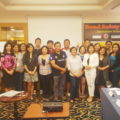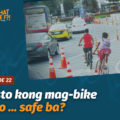With millions of young students heading back to school today, it is imperative that parents, teachers, the government and the community work together to ensure that kids are safe on the road and around their schools.
A large proportion of the estimated 27.7 million students enrolled this school year will take public transport or walk to school and will be exposed to extraordinary hazards on the road. Unsafe walking environments around schools add to their vulnerability and should be addressed through the creation of safe school zones.
According to the Philippine Statistics Authority (PSA), around 700 children died in road traffic crashes in 2016. The World Health Organization, in its 2018 Global Status Report on Road Safety, stated that traffic crashes are now the number one killer of children and young people aged 5 to 29 years.
In 2018, Safe Kids Worldwide Philippines (SKP) conducted a survey of 24 public elementary schools in Pasay, Paranaque, Quezon City and Angeles in Pampanga under its Walk this Way Pedestrian Safety Program. Among the children surveyed, it was found that 31% had experienced road traffic crashes involving bicycles (39%), pedicabs (21%), motorcycles (17%), jeepneys (7%), tricycles (6%) and other vehicles.
Survey results show that children face risks while they travel to school and back to their homes. SKP also found that based on the road design, many of these public elementary schools lack the necessary sidewalks, or when available, are occupied by vendors or heaps of garbage.
Crosswalks and other standard road safety signs are also absent. Meanwhile, students who walk to school early morning or late afternoon, when it is dark, are exposed to more hazards on the roads — uncovered manholes, unfinished roadwork or ongoing building construction.
There is also a lack of awareness of road safety on the part of both the children and adults who should be providing them guidance and supervision.
In addition, there are not enough traffic enforcers to oversee pedestrian crossings and busy street intersections.
A safe journey to school
How can we ensure a safe journey for our children?
Children should be prepared during their daily commute, both as pedestrians and passengers. Parents, for their part, should give them the following advice when walking on the streets:
- Always look left, right and left again when crossing the street. Since there could be open holes, it is wise to also look down;
- Walk and not run on the streets. No playing is allowed while on the road;
- Always use the sidewalks, pedestrian crossings and/or overpass when available;
- Always walk in groups so you are easily seen. Kids should not walk or cross the street alone;
- Obey traffic signs and follow traffic enforcers.
If the children are passengers, these safety reminders will help them:
- Observe loading and unloading signs so you know where to ride and where to get off the vehicle;
- No playing inside the jeepneys or buses. Sit properly and respect other passengers.
- Children should not ride motorcycles unless they can reach the foot peg and can grasp the waist of the driver (or motorcycle rider). Wear a standard helmet.
Developing safe school zones
Making the roads safe for children is a shared responsibility and requires close collaboration among the different stakeholders. The same is true for developing safe school zones where well-designed pedestrian facilities can reduce the risks especially for young pedestrians.
Safe Kids Philippines has been advocating for improvements in the walking environment for school children and we believe the education department and local government units can play important roles in promoting the program. Parents and teachers associations can also help campaign for safe school zones.
Initially, LGUs can assess the walking environment around certain schools and recommend or apply appropriate interventions. These include the segregation of pedestrians and vehicles through barriers, designating and painting pedestrian crosswalks for children, installing road signs, and assigning traffic enforcers on the roads for added protection for children.
It is only through the development of more safe school zones at the local level and eventually institutionalizing the program can families and communities be assured of the children’s safe journey to school. This is a matter of importance not just at the start of the school year but throughout the year.
Amalia Rolloque is the Program Manager of Safe Kids Philippines, a non-governmental organization committed to making the road, the home and the school safer for children by building capacity among concerned stakeholders: parents, children, local community members, schools, government, non-government organizations, corporations and institutions. Rolloque is part of the Bloomberg Initiative for Global Road Safety – Legal Development Programme (BIGRS-LDP), a fellowship of professionals advocating for the passage of evidence-based laws and policies on road safety.




